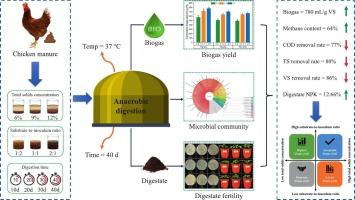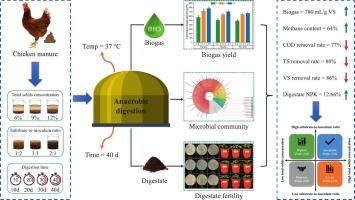Synergistic anaerobic digestion of chicken manure: Balancing biogas and biofertilizer via microbial dynamics and multivariate analysis
IF 4.3
2区 工程技术
Q2 ENGINEERING, CHEMICAL
引用次数: 0
Abstract
Optimizing anaerobic digestion (AD) parameters is a key factor in improving the performance of AD systems. This study investigates the synergistic effects of total solids (TS: 6, 9, 12 %), substrate-to-inoculum ratio (SIR: 1:2, 1:1, 2:1), and digestion time (10, 20, 30, 40 days) on biogas production, microbial dynamics, and digestate quality from chicken manure. Among the highest reported, the results revealed that TS 6 % coupled with SIR 2:1 achieved the highest cumulative biogas yield (780 mL/g VS) and methane content (489.7 mL CH4/g VS, 67 %). Stabilization was achieved within 20–30 days, approximately 40 % faster than higher TS systems. Microbial community analysis revealed that the optimal configuration not only maximized biogas production but also enriched beneficial microbial consortia, including Firmicutes, Fastidiosipila, and Syntrophomonas. Moreover, optimizing TS and SIR in the current AD system created ideal conditions for syntrophic microbial consortia. The digestate from this configuration exhibited > 90 % germination index and low phytotoxicity, confirming its viability as a biofertilizer. Multivariate analysis, including principal component analysis and response surface methodology, statistically validated the interdependence of operational parameters, demonstrating strong correlations between biogas yield, microbial composition, degradation efficiency, and digestate quality. These results demonstrated that optimum TS-SIR combinations can simultaneously enhance methane production, accelerate digestion kinetics, and ensure digestate safety, which is critical for industrial AD systems. This multi-factorial approach provides a framework for designing AD systems that contribute to sustainable agricultural practices and align with circular economy principles.


鸡粪协同厌氧消化:通过微生物动力学和多变量分析平衡沼气和生物肥料
优化厌氧消化(AD)参数是提高AD系统性能的关键因素。本研究探讨了总固体(TS: 6,9,12 %)、底物与接种物比(SIR: 1:2、1:1、2:1)和消化时间(10,20,30,40 天)对鸡粪沼气产量、微生物动力学和消化品质的协同效应。结果表明,TS 6 %配以SIR 2:1可获得最高的累积沼气产量(780 mL/g VS)和甲烷含量(489.7 mL CH4/g VS, 67 %)。稳定在20-30 天内实现,比更高的TS系统快约40% %。微生物群落分析表明,优化配置不仅能最大限度地提高沼气产量,还能丰富有益菌群,包括厚壁菌门(Firmicutes)、富菌门(Fastidiosipila)和合养单胞菌(Syntrophomonas)。此外,在现有的AD系统中优化TS和SIR,为共生微生物群体创造了理想的条件。这种结构的消化液表现出 >; 90 %的发芽指数和低的植物毒性,证实了它作为生物肥料的可行性。多变量分析,包括主成分分析和响应面法,统计验证了操作参数的相互依赖性,表明沼气产量、微生物组成、降解效率和消化质量之间存在很强的相关性。这些结果表明,最佳的TS-SIR组合可以同时提高甲烷产量,加速消化动力学,并确保消化安全,这对工业AD系统至关重要。这种多因素方法为设计有助于可持续农业实践并符合循环经济原则的可持续农业发展系统提供了框架。
本文章由计算机程序翻译,如有差异,请以英文原文为准。
求助全文
约1分钟内获得全文
求助全文
来源期刊

Chemical Engineering Science
工程技术-工程:化工
CiteScore
7.50
自引率
8.50%
发文量
1025
审稿时长
50 days
期刊介绍:
Chemical engineering enables the transformation of natural resources and energy into useful products for society. It draws on and applies natural sciences, mathematics and economics, and has developed fundamental engineering science that underpins the discipline.
Chemical Engineering Science (CES) has been publishing papers on the fundamentals of chemical engineering since 1951. CES is the platform where the most significant advances in the discipline have ever since been published. Chemical Engineering Science has accompanied and sustained chemical engineering through its development into the vibrant and broad scientific discipline it is today.
 求助内容:
求助内容: 应助结果提醒方式:
应助结果提醒方式:


